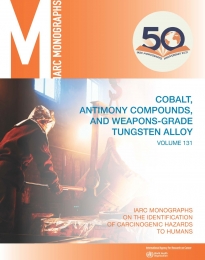
978-92-832-0171-7
978-92-832-0198-4
View The Lancet Oncology summary as HTML or PDF
French version of The Lancet Oncology summary (hosted by Centre Léon Bérard)
Read Q&A
View infographic
This volume of the IARC Monographs provides evaluations of the carcinogenicity of nine agents: cobalt metal (without tungsten carbide or other metal alloys), soluble cobalt(II) salts, cobalt(II) oxide, cobalt(II,III) oxide, cobalt(II) sulfide, other cobalt(II) compounds, trivalent antimony, pentavalent antimony, and weapons-grade tungsten (with nickel and cobalt) alloy.
Cobalt is used in the manufacture of cutting and grinding tools, in pigments, paints, coloured glass, medical implants, and electroplating, and in lithium-ion battery production. Occupational exposure is expected to occur predominantly during cobalt refining and production of cobalt compounds and dental materials; use of diamond–cobalt tools, plate painting with cobalt pigments, manufacture of nickel–hydrogen batteries, hard-metal production, and electronic-waste recycling. The general population is exposed via food, ambient air, tobacco smoke, and medical implants.
Antimony is used in flame retardants, lead–acid batteries, lead alloys, plastics, brake pads, clutch discs, glass and ceramics, and as a primer in explosives. Some pentavalent antimony compounds are used to treat leishmaniasis. Workers can be exposed during smelting, production of antimony compounds, manufacture of glass, textiles, and batteries, and electrical-waste processing. Non-occupational exposures occur via water, air, soil, consumer products, and tobacco.
Weapons-grade tungsten (with nickel and cobalt) alloy is used in armour-penetrating munitions. Occupational exposure can occur during munitions production, and military personnel and civilians can be exposed to metal aerosols generated during firing or impact, or via injuries with retained embedded fragments.
An IARC Monographs Working Group reviewed evidence from cancer studies in humans (available mainly for cobalt and antimony), cancer bioassays in experimental animals, and mechanistic studies to assess the carcinogenic hazard to humans of exposure to these agents and concluded that:
Cobalt metal (without tungsten carbide or other metal alloys) and some cobalt compounds
Trivalent and pentavalent antimony
Annex 1: Supplementary material for Section 1, Exposure Characterization
These tables are available only as supplementary web-only material.
Please report any errors to imo@iarc.who.int.
Cobalt metal (without tungsten carbide) and some cobalt compounds
Table S1.3 Global production of cobalt from mining, by country
Table S1.4 Global production of cobalt in refineries, by country
Table S1.10 Distribution of air concentrations of cobalt in industrial sectors, 1996–2016, Italy
Table S1.15 Occupational exposure limits of cobalt and its compounds in different countries
Table S1.16 Environmental regulations and guidelines for cobalt
Table S1.17 Biomonitoring guidance and reference values for cobalt
The following tables were produced in draft form by the Working Group and were subsequently fact-checked but not edited:
Trivalent and pentavalent antimony
The following tables were produced in draft form by the Working Group and were subsequently fact-checked but not edited.
Weapons-grade tungsten (with cobalt and nickel) alloy
This table was produced in draft form by the Working Group and subsequently fact-checked but not edited.
Annex 2: Supplementary material for Section 2, Cancer in Humans
These tables are available only as supplementary web-only material.
Please report any errors to imo@iarc.who.int.
Cobalt metal (without tungsten carbide) and some cobalt compounds
Annex 3: Supplementary material for Section 4, Mechanistic Evidence
These tables are available only as supplementary web-only material.
Please report any errors to imo@iarc.who.int.
Cobalt metal (without tungsten carbide) and some cobalt compounds
Table S4.6 Genetic and related effects of cobalt in non-mammalian experimental systems
Table S4.7 Genetic and related effects of cobalt in acellular systems
Table S4.14 Oxidative stress in non-human mammals in vivo exposed to cobalt
Table S4.16 Acute pro-inflammatory effects in human cells in vitro exposed to cobalt
These supplementary web-only tables contain summaries of the findings (including the assay name, the corresponding key characteristic, the resulting “hit calls” both positive and negative, and any reported caution flags) for those chemicals evaluated in the present volume that have been tested in high-throughput screening assays performed by the United States Environmental Protection Agency (US EPA) and the United States National Institutes of Health. The results were generated by the Working Group using the software “kc-hits” (key characteristics of carcinogens – high-throughput screening discovery tool) available from https://gitlab.com/i1650/kc-hits.git (Reisfeld et al., 2022), using the US EPA Toxicity Forecaster (ToxCast) assay data and the curated mapping of key characteristics to assays available at the time of the evaluations performed for IARC Monographs Volume 131. Data were available for cobalt metal (without tungsten carbide) and cobalt(II) salts, and trivalent and pentavalent antimony, but not for weapons-grade tungsten (with cobalt and nickel) alloy.
Please report any errors to imo@iarc.who.int.
Cobalt metal (without tungsten carbide) and some cobalt compounds
1. Cobalt(II) sulfate heptahydrate: ToxCast/Tox21 assay results mapped to the key characteristics of carcinogens
Trivalent and pentavalent antimony
1. Acetic acid, antimony(III) salt: ToxCast/Tox21 assay results mapped to the key characteristics of carcinogens
2. Antimony potassium(III) tartrate trihydrate: ToxCast/Tox21 assay results mapped to the key characteristics of carcinogens
3. Antimony(III) trichloride: ToxCast/Tox21 assay results mapped to the key characteristics of carcinogens
4. Antimony(V) sulfide: ToxCast/Tox21 assay results mapped to the key characteristics of carcinogens
5. Antimony(III) potassium tartrate hydrate: ToxCast/Tox21 assay results mapped to the key characteristics of carcinogens
6. Triphenylstibine(III): ToxCast/Tox21 assay results mapped to the key characteristics of carcinogens